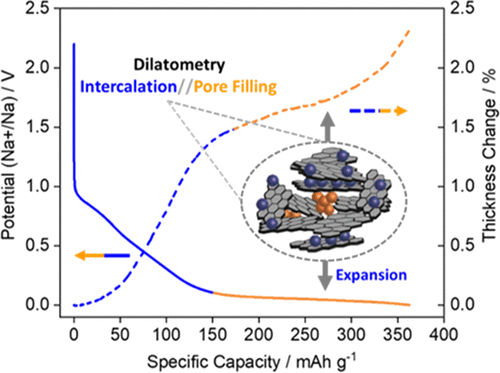当前位置:
X-MOL 学术
›
ACS Appl. Energy Mater.
›
论文详情
Our official English website, www.x-mol.net, welcomes your feedback! (Note: you will need to create a separate account there.)
Sodium Storage Mechanism Investigations through Structural Changes in Hard Carbons
ACS Applied Energy Materials ( IF 6.4 ) Pub Date : 2020-09-18 , DOI: 10.1021/acsaem.0c01614 Hande Alptekin 1 , Heather Au 1 , Anders CS Jensen 1, 2 , Emilia Olsson 1, 2, 3 , Mustafa Goktas 4 , Thomas F. Headen 5 , Philipp Adelhelm 4 , Qiong Cai 3 , Alan J Drew 2 , Maria-Magdalena Titirici 1
ACS Applied Energy Materials ( IF 6.4 ) Pub Date : 2020-09-18 , DOI: 10.1021/acsaem.0c01614 Hande Alptekin 1 , Heather Au 1 , Anders CS Jensen 1, 2 , Emilia Olsson 1, 2, 3 , Mustafa Goktas 4 , Thomas F. Headen 5 , Philipp Adelhelm 4 , Qiong Cai 3 , Alan J Drew 2 , Maria-Magdalena Titirici 1
Affiliation

|
Hard carbons, due to their relatively low cost and good electrochemical performance, are considered the most promising anode materials for Na-ion batteries. Despite the many reported structures of hard carbon, the practical use of hard carbon anodes is largely limited by low initial Coulombic efficiency (ICE), and the sodium storage mechanism still remains elusive. A better understanding of the sodium-ion behavior in hard carbon anodes is crucial to develop more efficient sodium-ion batteries. Here, a series of hard carbon materials with tailored morphology and surface functionality was synthesized via hydrothermal carbonization and subsequent pyrolysis from 1000 to 1900 °C. Electrochemical results revealed different sodiation-desodiation trends in the galvanostatic potential profiles and varying ICE and were compared with theoretical studies to understand the effect of the varying hard carbon structure on the sodium storage process at different voltages. Furthermore, electrode expansion during cycling was investigated by in situ dilatometry; to the best of our knowledge, this is the first time that the technique has been applied to hard carbons for ion storage mechanism investigation in Na-ion batteries. Combining experimental and theoretical results, we propose a model for sodium storage in our hard carbons that consist of Na-ion storage at defect sites and by intercalation in the high voltage slope region and via pore filling in the low voltage plateau region; these findings are important for the design of future electrode materials with high capacity and efficiency.
中文翻译:

通过硬碳的结构变化研究钠储存机理
硬碳由于其相对较低的成本和良好的电化学性能,被认为是钠离子电池最有希望的负极材料。尽管已报道了许多硬碳结构,但硬碳阳极的实际使用在很大程度上受到较低的初始库仑效率(ICE)的限制,并且钠存储机制仍然难以捉摸。更好地了解硬碳阳极中钠离子的行为对于开发更高效的钠离子电池至关重要。在这里,通过水热碳化和随后在1000至1900°C的热解,合成了一系列具有定制的形态和表面功能的硬碳材料。电化学结果表明,在恒电流电位分布和不同的ICE中,有不同的消沉-脱硫趋势,并与理论研究进行了比较,以了解变化的硬碳结构在不同电压下对钠存储过程的影响。此外,通过原位膨胀法研究了循环过程中的电极膨胀。据我们所知,这是该技术首次应用于硬碳,用于钠离子电池的离子存储机理研究。结合实验和理论结果,我们提出了一种在我们的硬碳中钠存储的模型,该模型由缺陷部位的钠离子存储,在高压斜坡区域的插层和在低压高原区域的孔隙填充组成;
更新日期:2020-10-26
中文翻译:

通过硬碳的结构变化研究钠储存机理
硬碳由于其相对较低的成本和良好的电化学性能,被认为是钠离子电池最有希望的负极材料。尽管已报道了许多硬碳结构,但硬碳阳极的实际使用在很大程度上受到较低的初始库仑效率(ICE)的限制,并且钠存储机制仍然难以捉摸。更好地了解硬碳阳极中钠离子的行为对于开发更高效的钠离子电池至关重要。在这里,通过水热碳化和随后在1000至1900°C的热解,合成了一系列具有定制的形态和表面功能的硬碳材料。电化学结果表明,在恒电流电位分布和不同的ICE中,有不同的消沉-脱硫趋势,并与理论研究进行了比较,以了解变化的硬碳结构在不同电压下对钠存储过程的影响。此外,通过原位膨胀法研究了循环过程中的电极膨胀。据我们所知,这是该技术首次应用于硬碳,用于钠离子电池的离子存储机理研究。结合实验和理论结果,我们提出了一种在我们的硬碳中钠存储的模型,该模型由缺陷部位的钠离子存储,在高压斜坡区域的插层和在低压高原区域的孔隙填充组成;



























 京公网安备 11010802027423号
京公网安备 11010802027423号